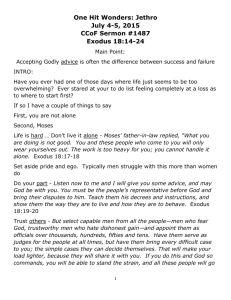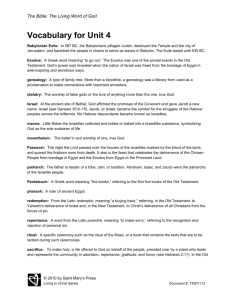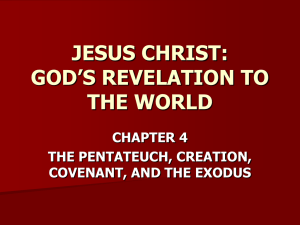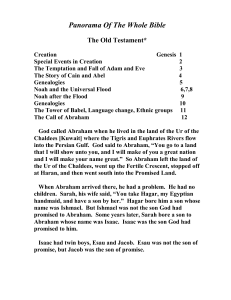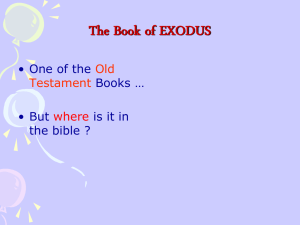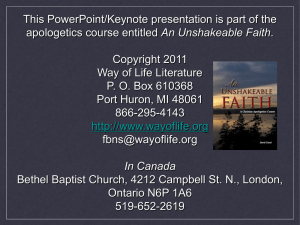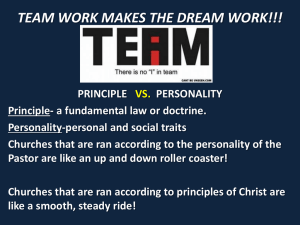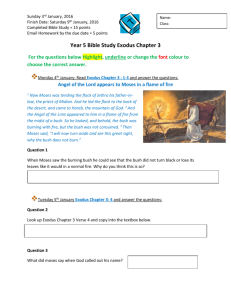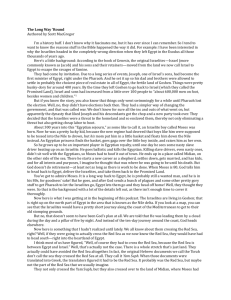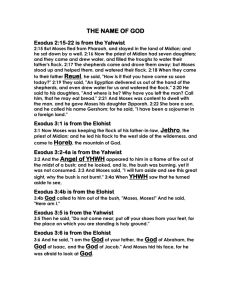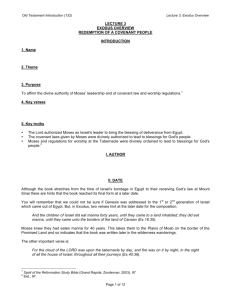Road Trip: Getting to Know God
advertisement
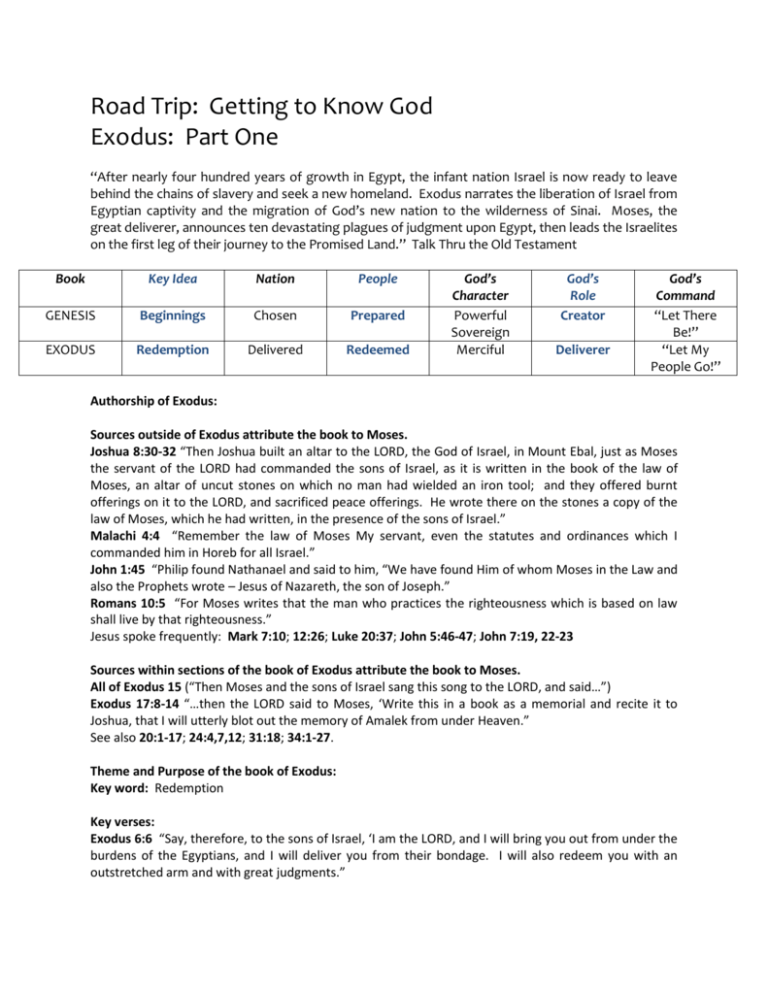
Road Trip: Getting to Know God Exodus: Part One “After nearly four hundred years of growth in Egypt, the infant nation Israel is now ready to leave behind the chains of slavery and seek a new homeland. Exodus narrates the liberation of Israel from Egyptian captivity and the migration of God’s new nation to the wilderness of Sinai. Moses, the great deliverer, announces ten devastating plagues of judgment upon Egypt, then leads the Israelites on the first leg of their journey to the Promised Land.” Talk Thru the Old Testament Book Key Idea Nation People GENESIS Beginnings Chosen Prepared EXODUS Redemption Delivered Redeemed God’s Character Powerful Sovereign Merciful God’s Role Creator Deliverer God’s Command “Let There Be!” “Let My People Go!” Authorship of Exodus: Sources outside of Exodus attribute the book to Moses. Joshua 8:30-32 “Then Joshua built an altar to the LORD, the God of Israel, in Mount Ebal, just as Moses the servant of the LORD had commanded the sons of Israel, as it is written in the book of the law of Moses, an altar of uncut stones on which no man had wielded an iron tool; and they offered burnt offerings on it to the LORD, and sacrificed peace offerings. He wrote there on the stones a copy of the law of Moses, which he had written, in the presence of the sons of Israel.” Malachi 4:4 “Remember the law of Moses My servant, even the statutes and ordinances which I commanded him in Horeb for all Israel.” John 1:45 “Philip found Nathanael and said to him, “We have found Him of whom Moses in the Law and also the Prophets wrote – Jesus of Nazareth, the son of Joseph.” Romans 10:5 “For Moses writes that the man who practices the righteousness which is based on law shall live by that righteousness.” Jesus spoke frequently: Mark 7:10; 12:26; Luke 20:37; John 5:46-47; John 7:19, 22-23 Sources within sections of the book of Exodus attribute the book to Moses. All of Exodus 15 (“Then Moses and the sons of Israel sang this song to the LORD, and said…”) Exodus 17:8-14 “…then the LORD said to Moses, ‘Write this in a book as a memorial and recite it to Joshua, that I will utterly blot out the memory of Amalek from under Heaven.” See also 20:1-17; 24:4,7,12; 31:18; 34:1-27. Theme and Purpose of the book of Exodus: Key word: Redemption Key verses: Exodus 6:6 “Say, therefore, to the sons of Israel, ‘I am the LORD, and I will bring you out from under the burdens of the Egyptians, and I will deliver you from their bondage. I will also redeem you with an outstretched arm and with great judgments.” Exodus 19:5-6 “Now then, if you will indeed obey My voice and keep My covenant, then you shall be My own possession among all the peoples, for all the earth is Mine; and you shall be to Me a kingdom of priests and a holy nation. These are the words that you shall speak to the sons of Israel.” Key chapters: “The climax of the entire Old Testament is recorded in chapters 12-14: the salvation of Israel through blood (the Passover) and through power (the Red Sea). Just as the cross is the central event of the New Testament, the Exodus is the central event of the Old Testament.” Christ in Exodus: The Exodus is full of types and portraits of Christ. Moses: prophet, priest, king (Moses functioned as the ruler of Israel), kinsman-redeemer, endangered in infancy, voluntarily renounced wealth and power, deliverer, lawgiver, and mediator, as was Christ. The Passover: Christ is our slain God and the Passover Lamb as seen in John 1:29,36 and 1 Corinthians 5:7. The seven feasts: Each of the feasts of Israel portrays in some way the ministry of Christ. The Exodus: Paul relates baptism to the Exodus event because baptism symbolizes death to the old and identification with the new. (Romans 6:2-3; 1 Corinthians 10:1-2) The manna and water: The NT applies both of these to Christ. (John 6:31-35, 48-63; 1 Corinthians 10:34) The tabernacle: The tabernacle clearly speaks of the person of Christ and the way of redemption in its materials, colors, furniture, and arrangement. The progression moves from suffering, blood, and death, to beauty, holiness, and the glory of God. The tabernacle is theology in a physical form. The high priest: The high priest foreshadows the ministry of Christ, our Great High Priest. (Hebrews 4:14-16; 9:11-12,24-28) Contribution to the Bible: Exodus is foundational for the history of Israel. It describes how the Israelites escaped from Egypt, became the covenant people of God, and came to know His presence and His ways. Exodus provides the greatest example of the saving acts of God before Christ. The Passover, the Exodus, Moses, the Law, and the tabernacle dominated the thought of Israel for centuries to come. Survey: Exodus is full of God’s redemptive acts on behalf of His oppressed people. It begins in pain and ends in liberation; from groaning of the people to the glory of God. It is the continuation of the story that begins in Genesis with the seventy descendants of Jacob who move from Canaan to Egypt. They have multiplied under adverse conditions to a multitude of ever two million people. When the Israelites finally turn to God for deliverance from their bondage, God quickly responds by redeeming them “with and outstretched arm and with great judgments” (6:6). God faithfully fulfills His promise made to Abraham centuries before. (Genesis 15:13-14) Two parts: Part One - Redemption from Egypt (chapters 1-18) After four centuries of slavery, the people of Israel cry to the God of Abraham, Isaac, and Jacob for deliverance. God has already prepared Moses for this purpose, and has commissioned him at the burning bush to stand before Pharaoh as the advocate for Israel. However, Pharaoh hardens his heart: “Who is the LORD, that I should obey His voice to let Israel go?” (5:2) God soon reveals Himself to Pharaoh through a series of object lessons, the ten plagues. These plagues grow in severity until the tenth brings death to the firstborn of every household of Egypt. Israel is redeemed through this plague by means of the Passover lamb. The Israelite’s faith in God at this point becomes the basis for their national redemption. As they leave Egypt, God guides them by a pillar of fire and smoke, and saves them from Egypt’s pursuing army through the miraculous crossing of the sea. In the wilderness He protects and sustains them throughout their journeys. Part Two - Revelation from God (chapters 19-40) Now that the people have experienced God’s deliverance, guidance, and protection, they are ready to be taught what God expects of them. The redeemed people must now be set apart to walk with God. This is why the emphasis moves from the narration in chapters 1-18 to the legislation in chapters 19-40. N Mount Sinai, Moses receives God’s moral, civil, and ceremonial laws, as well as the pattern for the tabernacle to be built in the wilderness. After God judges the people for their worship of the golden calf, the tabernacle is constructed and consecrated. It is a building of beauty in a barren land and reveals much about the person of God and the way of redemption. These study notes are gleanings from several sources which I am listing below: “Talk Thru the Old Testament” by Bruce Wilkinson and Kenneth Boa “Through the Pentateuch Chapter by Chapter” by W. H. Griffith Thomas “Walk Thru the Old Testament” by Walk Thru the bible Ministries “Walk Thru the Pentateuch” a video series and notes by Dr. Bruce H. Wilkinson
